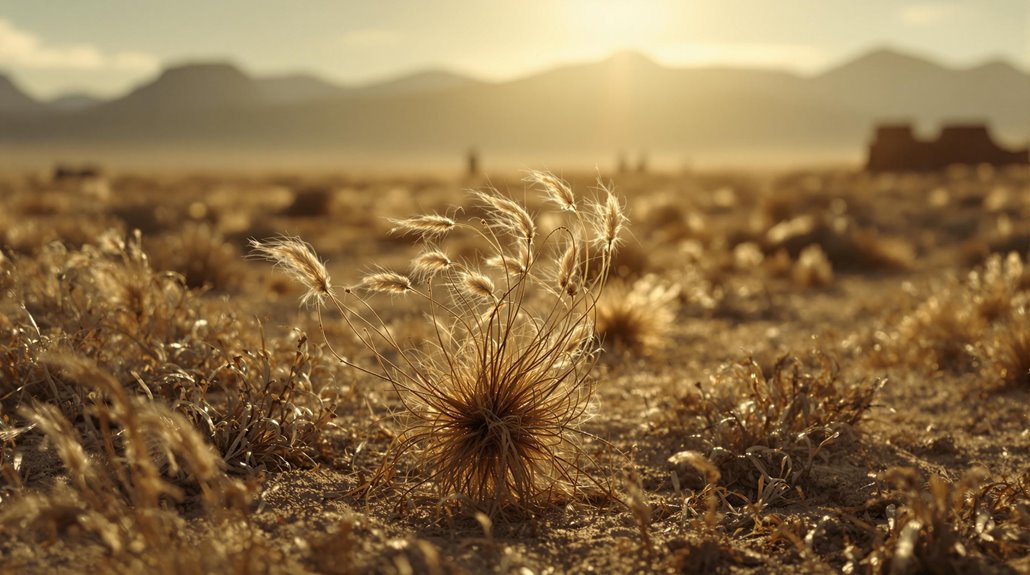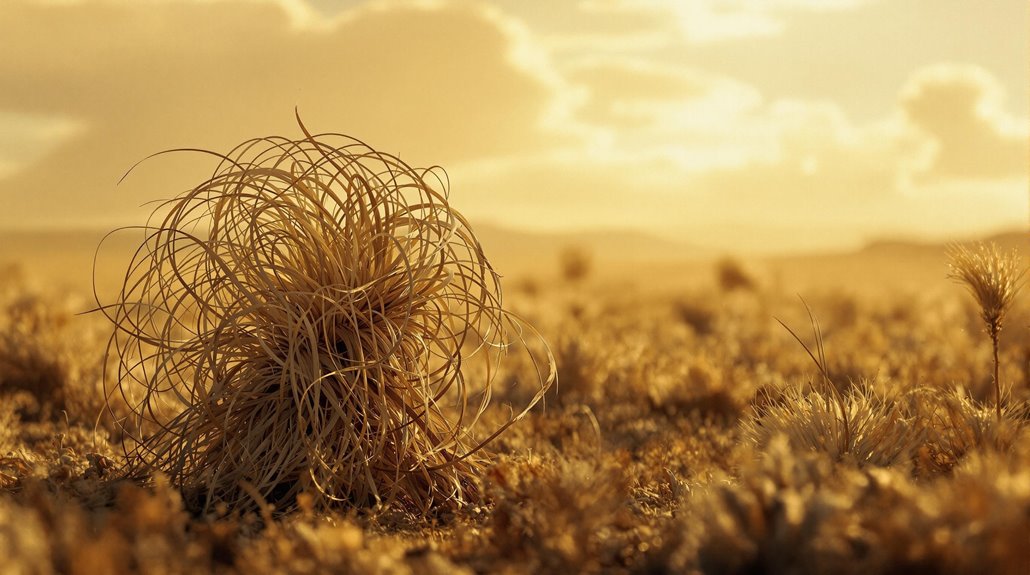Tumbleweeds: The Russian Invaders Taking Over the West
You've probably seen them bouncing across dusty highways or piling up against fences in old Western films, but tumbleweeds aren't the charming symbols of Americana you might think. These Russian invaders have quietly transformed the American West since their accidental arrival in the 1870s, leaving a trail of agricultural havoc and environmental destruction in their wake. What began with a few contaminated flaxseed shipments has evolved into one of the most successful biological invasions in U.S. history.
From Russia With Seeds: the Origin Story of American Tumbleweeds

When you imagine iconic symbols of the American West, tumbleweeds likely roll through your mind, yet these distinctive plants aren't native to North America at all.
In the historical context of the 1870s, this invasive species first appeared in South Dakota through a seemingly innocent shipment of flax seeds from Russia. While some accounts suggest the seeds hitchhiked with Mennonite immigrants in their hay and straw, what's clear is that this plant, scientifically known as Salsola tragus, would soon transform America's landscape. A single plant is capable of producing up to a quarter million seeds.
You might find it hard to believe, but this accidental introduction sparked one of the fastest plant invasions in U.S. history. Within just two decades, Russian thistle had already spread across 35,000 square miles, marking the beginning of its relentless march across the continent. These plants can grow incredibly large, with Ryan's tumbleweed species reaching heights equal to that of an adult human.
A Plant Built for Survival: Understanding Tumbleweed Biology
Nature's ingenious design makes the Russian thistle a master of survival.
You'll find this remarkable plant thriving where others can't, thanks to its impressive drought adaptation features. Its taproot plunges several feet into the soil, while its bushy structure, reaching up to 6 feet in diameter, sports spiny leaves that ward off hungry herbivores. The plant's arrival from Russia in 1870 forever changed the American landscape.
These invasive plants are particularly concerning as a single Russian thistle can extract up to 170 liters of water from the soil each year. What's truly fascinating is how this plant guarantees its legacy. A single tumbleweed produces up to 250,000 seeds, and though seed viability only lasts 1-3 years, it's the plant's unique dispersal method that makes it so successful.
When mature, it breaks free from its root, becoming a rolling sphere that scatters seeds across vast distances. Whether tumbling across plowed fields or floating in irrigation canals, it's engineered to spread its offspring far and wide.
Rolling Across the Plains: How Tumbleweeds Conquered the West
Through a chance arrival of contaminated flaxseed in South Dakota in 1873, Russian thistle began one of the fastest plant invasions in U.S. history.
Within just 20 years, you'd find these resilient plants covering an astounding 35,000 square miles of American soil. Today, a new species called Salsola ryanii has emerged in California, adding to the tumbleweed family's expansion. As railways expanded and livestock roamed, tumbleweeds hitchhiked their way across the nation, eventually reaching every state except Florida and Alaska.
During the devastating Dust Bowl of the 1930s, these plants proved surprisingly useful as emergency cattle feed, with farmers producing over 350,000 tonnes in 1934 alone.
Key factors that fueled this remarkable expansion:
- Each plant's ability to produce up to 250,000 seeds
- The removal of native prairie grasses, creating perfect growing conditions
- Extensive railway networks serving as distribution highways
- Disturbed soil from westward expansion offering ideal habitats
This rapid spread helped cement the tumbleweed's place in American cultural symbolism, transforming it from an invasive species into an iconic element of tumbleweed mythology and Western identity.
The True Cost: Economic and Environmental Impact
Despite its iconic status in Western culture, the Russian thistle's invasion has extracted a staggering economic and environmental toll across America.
You'll find its economic consequences rippling through agriculture, where it slashes wheat yields by up to 50% and forces farmers to spend over $50 million yearly on control measures. The weed infests nearly 5 million acres in the Pacific Northwest alone.
The environmental degradation is equally severe. When you look at cropland and rangeland, you'll see how these invasive plants host crop-damaging viruses and fuel wildfire spread. Public agencies spend significant resources removing these spiny, brittle tumbleweeds that accumulate against structures and block roadways. Some researchers have explored using the plant as an energy crop alternative, calculating substantial yields of 28 metric tons per hectare.
They've become particularly problematic in disturbed areas with sandy soils, where they outcompete native plants. While the plant showed surprising value during the Dust Bowl era as emergency cattle feed, today's costs – from livestock illness to wilderness degradation – far outweigh these historical benefits.
Fighting Back: Modern Solutions for Tumbleweed Control

As tumbleweeds continue their relentless march across American landscapes, land managers and property owners have developed an extensive arsenal of control methods.
You'll need to implement multiple strategies to effectively combat these invasive plants.
These invasive plants thrive in disturbed soil areas like ditches, roadsides, and construction sites.
Here's what you can do to fight back:
- Apply cultural control methods by reseeding with native plants and maintaining well-irrigated properties.
- Use mechanical techniques like mowing before flowering, which can reduce seed density by up to 98%.
- Deploy chemical strategies through pre-emergent herbicides in spring and post-emergent treatments in summer.
- Adopt integrated management approaches that combine all methods over 2-3 years.
You'll find the most success by using these solutions together rather than relying on a single approach.
Remember to monitor your progress and adjust your strategy as needed throughout the growing season.
The Russian thistle species first appeared in the United States in 1873 through contaminated flax seeds and has since become a widespread problem.










